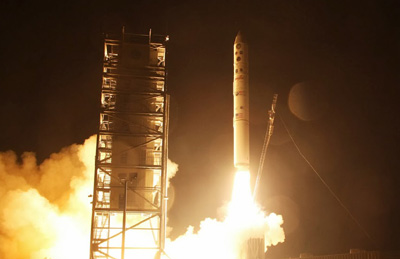
NASA robotic spacecraft blasts off to moon
Florida, September 7, 2013
An unmanned Minotaur 5 rocket blasted off from the Virginia coast on Friday to send a small National Aeronautics and Space Administration (NASA) science satellite on its way to the moon, officials said.
The Lunar Atmosphere and Dust Environment Explorer spacecraft (Ladee), was designed to look for dust rising from the lunar surface, a phenomenon reported by the Apollo astronauts decades ago.
"For the first time in 40 years, we have the opportunity to address that mystery," project scientist Richard Elphic, with NASA's Ames Research Center in Moffett Field, California, said during a launch broadcast on NASA TV.
From an orbit as low as about 31 miles (50 km) above the lunar surface, Ladee also will probe the thin pocket of gases surrounding the moon. The tenuous atmosphere, which contains argon, helium, sodium, potassium and other elements, may hold clues about how water came to be trapped inside craters on the moon's frozen poles.
"We're taught in grade school and probably junior high that the moon has no atmosphere," Elphic said.
"Indeed it does have an atmosphere, but it's utterly unlike our own atmosphere. It's very tenuous," he said.
Ladee's 30-day trip to the moon began with an 11:27 p.m. EDT/0327 GMT Saturday liftoff of a five-stage Minotaur rocket making its debut flight. The first three stages are decommissioned intercontinental ballistic missile motors, and the last two stages are commercial motors manufactured by Alliant Techsystems Inc.
The rocket blasted off from the Mid-Atlantic Regional Spaceport at NASA's Wallops Island Flight Facility, the first deep-space mission to fly from the Virginia spaceport.
Weather permitting, the rocket was expected to be visible from Maine to eastern North Carolina, and as far west as Wheeling, West Virginia. New Yorkers were due to be treated to a live televised view of the launch on the Toshiba Vision Screen in Times Square, just below the site where the famous New Year's Eve ball is dropped.
The use of decommissioned missile components drove the decision to fly from Wallops Island, one of only a few launch sites permitted to fly refurbished ICBMs under U.S.-Russian arms control agreements.
Ladee's month-long journey to the moon includes three highly elliptical passes around Earth, timed so that during the final orbit the probe will be far enough away to be captured by the moon's gravity after Ladee fires its braking rocket.
Once Ladee is in lunar orbit, scientists will check out the spacecraft's three instruments and test a prototype optical laser communications system. Science operations are expected to begin in November.
"This is a science mission, but it has some new technology," Pete Worden, director of NASA's Ames Research Center, told Reuters. "We're confident stuff will work, but we certainly will be watching very, very carefully as each of these new things unfolds."
The $280 million mission is expected to last about six months.-Reuters







